World War 2 was the greatest armed conflict in history, a truly global war in which Canada played an important part. The entire country was focused on working toward a speedy victory for Canada and her allies through the formation of a strong military force and production and supply of goods and materials in support of the war effort.
Richmond sent many of her young men and women to serve in the military, at home and overseas, many of whom paid the ultimate price for their service. Their sacrifice is remembered every year on Remembrance Day.
On the home front in Richmond, everyday life steered toward supporting the military in its work. Under the National Registration Regulations, enacted in 1940, all persons in Canada, age 16 or over, were required to register with the government, supplying details of their age, family, work history, national and racial origins, etc. This allowed the authorities to direct the service of each person, whether that lay in the military, in war production, or in the maintenance of services allowing life in the nation to continue in a routine manner.
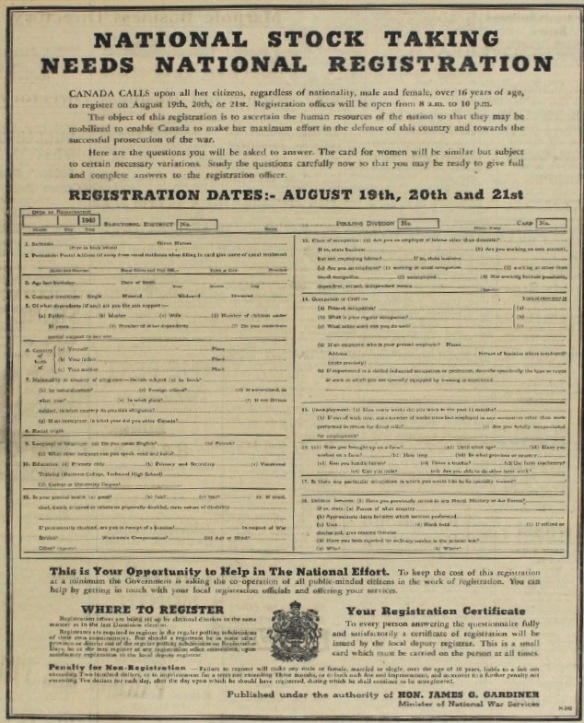 All persons aged 16 and over were required to register for service during the war. Ad from Marpole-Richmond Review July 31, 1940.
All persons aged 16 and over were required to register for service during the war. Ad from Marpole-Richmond Review July 31, 1940.Everyday Life in Wartime
Rationing of materials became commonplace. Items such as gasoline and other fuels, rubber goods, like tires, and metals were either not available or could only be purchased using ration coupons. The same was true for many household items like sugar, meat, coffee, etc. Many guides were published to help people deal with shortages and the reduced quantities of goods that they could get. Programs were put in place and drives were held to collect scrap material like metals, scrap paper, cooking grease and bones, etc., all to go to wartime industry.
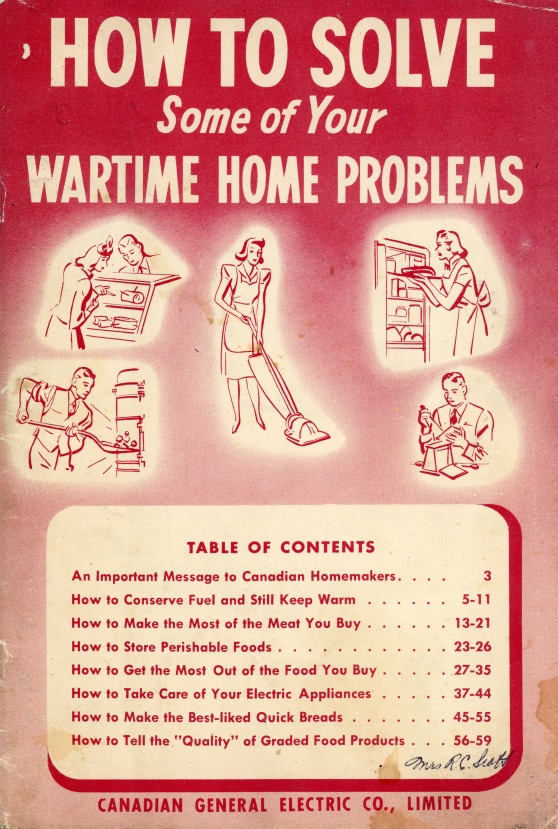
Guides to help people deal with rationing were published by many companies and government agencies, such as this one from Canadian General Electric. City of Richmond Archives reference files.
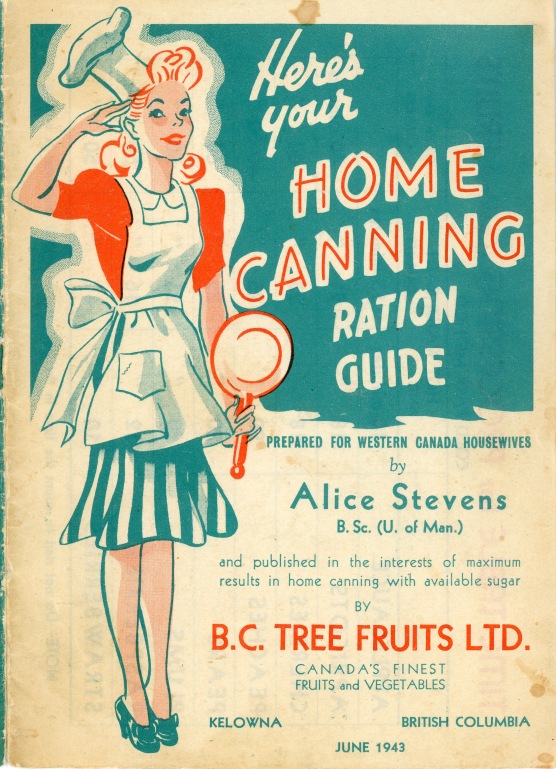
And this one from B.C. Tree Fruits Ltd. City of Richmond Archives reference files.
Calls for volunteers for organizations like the Red Cross and the Home Defence Corps were met by local residents who contributed their time away from other jobs to take part. Women and teenagers too young for the military took over many of the jobs which had been vacated by men leaving for military service.
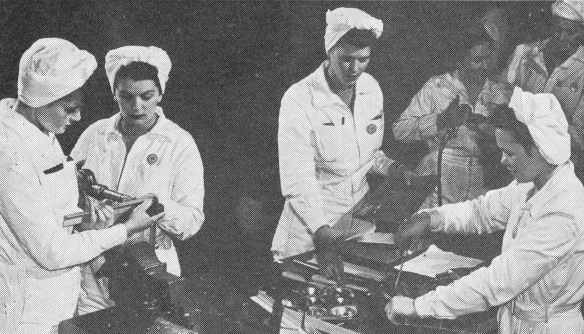
Women are trained to assemble aircraft at the Sea Island Boeing Plant in this image from 1943. Boeing Beam October 13,1943.
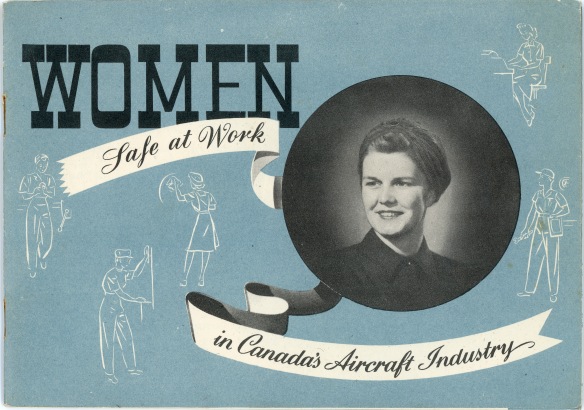
This booklet produced by Boeing Canada gave new female employees tips on how to be safe in an industrial setting, which until the war was unavailable to them. City of Richmond Archives reference files.
In March 1942, the National Selective Service was enacted “to effect the orderly and efficient employment of the men and women of Canada for the varied purposes of war.” Administered through the Department of Labour, the act allowed the government to dictate which jobs got preference for manning and gave them the power to move people out of low priority jobs and into higher ones.
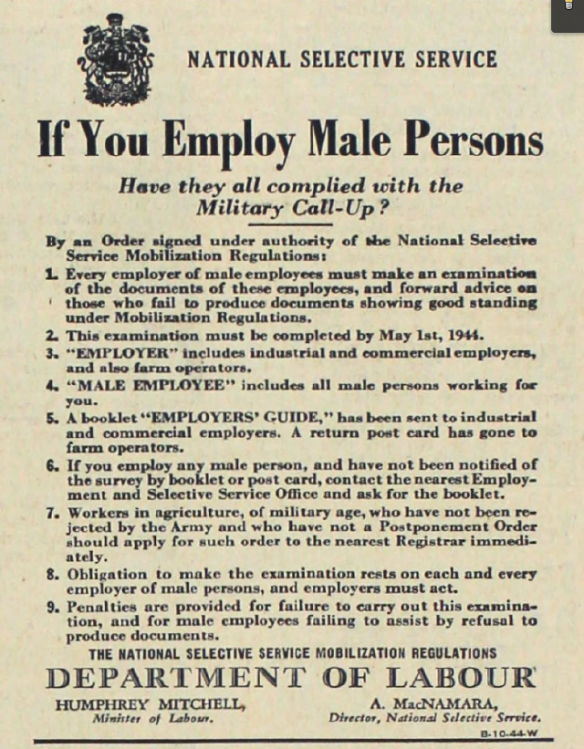
The National Selective Service Mobilization Regulations gave the Department of Labour sweeping powers over manpower in Canada.
Manning shortages were a continual problem in Richmond during the war, not in small part to the removal and internment of around 2,500 Japanese-Canadians from the area in early 1942.
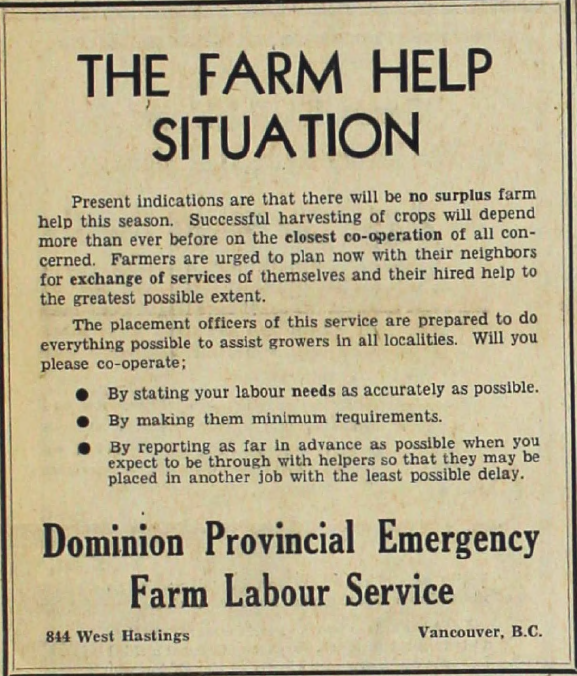
Regular ads appeared in newspapers looking for labourers for farms and workers in other areas were encouraged to do extra work as farm workers.
The fishing industry imported workers to fill the void and there were regular ads in local papers looking for farm workers during planting and harvest periods.
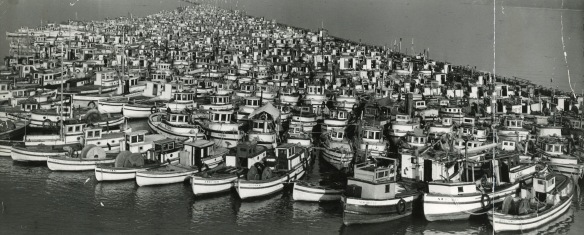
Hundreds of fishboats, confiscated from Japanese-Canadians in 1942, sit at Annieville. Property that was confiscated such as boats, houses, businesses, etc., were never returned to their owners after the war. City of Richmond Archives, Photograph #1985 4 1753.
The people of Richmond signed up in droves for the many War Bond drives that were held during the war to help finance Canada’s War effort.
Protecting Richmond
The protection of Richmond’s people and infrastructure from potential attack was a priority during the war. At Steveston an army camp and shore battery was built to guard the mouth of the Fraser River. It was equipped with an 18 pounder artillery piece, later replaced by two 25-pounder guns. Four anti-aircraft batteries were installed to protect the airport, flight training school and aircraft plant – three on Sea Island and one on Lulu Island. Local residents were warned to open all the windows in their houses during target practice, a strategy which did not always prevent cracked windows.
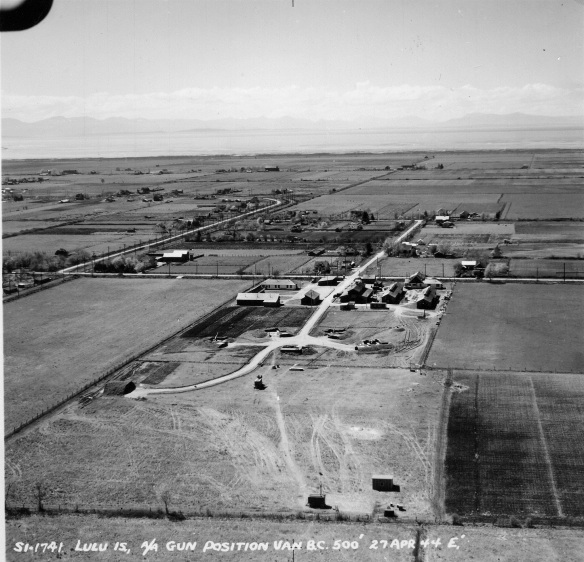
This anti-aircraft battery and camp was located just north of Granville Ave. near the Interurban Tram Line where it curves onto Railway Ave. City of Richmond Archives, Photograph #2013 49 2.
More than 90 men signed up to enlist in No.125 (Richmond) Company Pacific Coast Militia Rangers, Richmond’s home guard unit. Given military training, these men would have made the first response to any attack on the area.
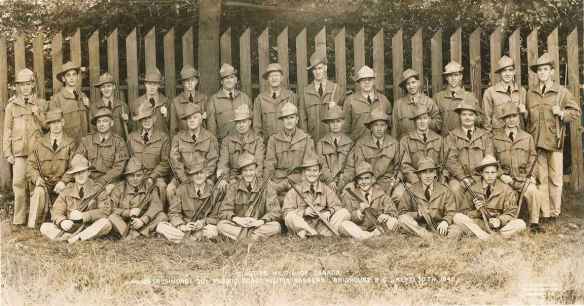
Members of No. 125 (Richmond) Company Pacific Coast Militia Rangers pose in September 1945. These men formed Richmond’s home guard unit during the war. City of Richmond Archives, Photograph #1988 17 1a.
Richmond’s Volunteer Firefighters formed Canada’s first Air Raid Precaution unit, building much of their own equipment and putting in countless hours fighting fires and enforcing the Blackout imposed on coastal areas to protect against nighttime attacks.
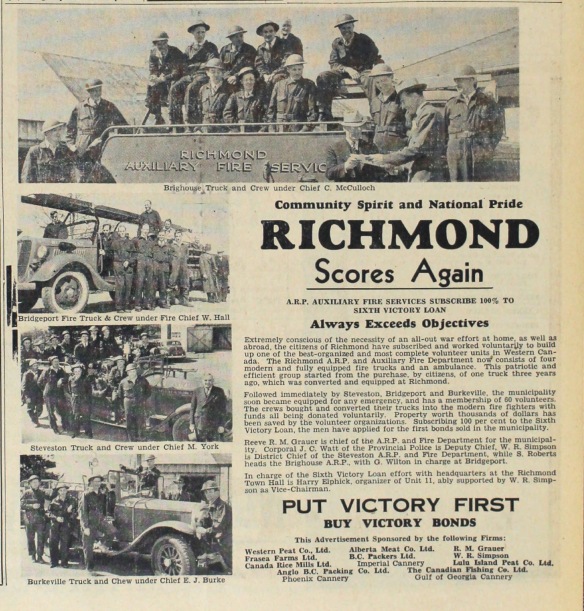
This ad for the sixth Victory Loan drive from an April 1944 Marpole-Richmond Review featured Richmond’s Volunteer ARP / Firefighters. The Steveston volunteers formed the first ARP unit in Canada, building most of their own equipment, including a fire truck. Marpole-Richmond Review April 26, 1944.
Wartime Industry
The largest employer in Richmond during the War was the Boeing Canada aircraft plant on Sea Island. The plant worked through most of the war building Consolidated PBY-5a amphibian patrol bombers, known as Catalinas in American service and Cansos in Canadian service. Toward the end of the war the plant made parts for the B-29 Superfortress bomber which were shipped south to a plant in Renton, Washington where the planes were completed.
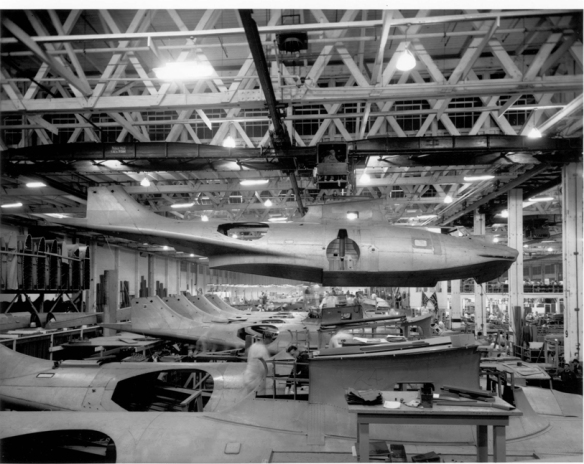
The hull of a PBY-5a patrol bomber is lifted by a crane in the Boeing Canada aircraft plant on Sea Island. 362 PBYs were built during the war at this plant which employed around 7,000 people at its peak. City of Richmond Archives, Photograph #1985 199 1.
About 7,000 people were employed at the plant during its peak. A shortage of housing for its workers led to the development of Burkeville, named for Boeing Canada president Stanley Burke.
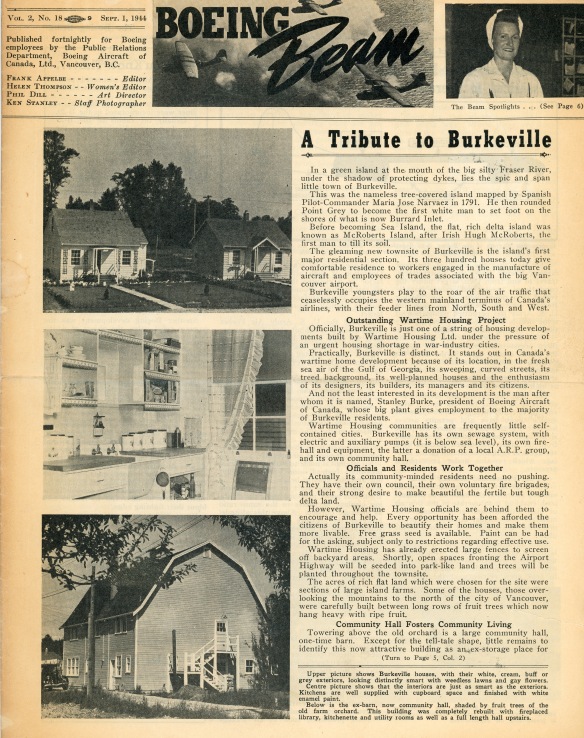
The front page of the Boeing Beam newsmagazine featured a story about Burkeville, built to house workers at the aircraft plant. Boeing Beam September 1, 1944.
The peat mining industry had one of the highest priorities for manning during the war. Sphagnum moss was used as a catalyst for the extraction of magnesium, used in the production of incendiary devices and munitions, and it was shipped to the US in large quantities from Richmond. Several large bog fires during the war interrupted production and resulted in the loss of thousands of dollars worth of peat.
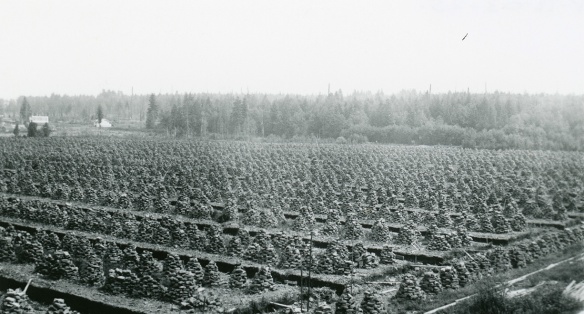
Stacks of peat blocks dry in a Richmond field in this photo. Peat mining was a very important industry during the war. It was used in the processing of magnesium which was vital for the production of munitions. City of Richmond Archives, Photograph #1978 3 25.
The need for large amounts of food products put Richmond’s fishing and farming industries on full production. Products from our area were shipped out for use by the military as well as to provide much needed supplies for Great Britain and our other allies in war ravaged areas.
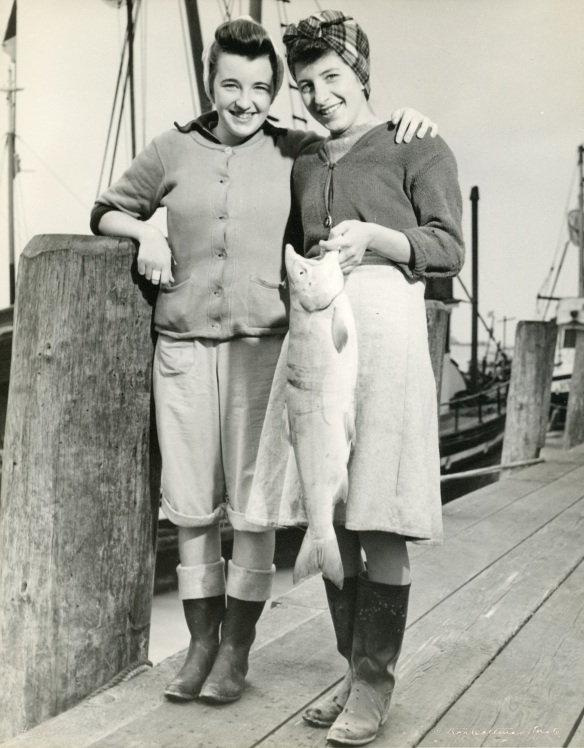
Food production was another industry that was vital to the war effort. “Salmon for Britain” was a slogan used to encourage productivity in local canneries. City of Richmond Archives, Photograph #1985 4 1759.
Smaller industries, such as lumber production, fabrication and machine shops also contributed to the war effort, all under the control of the Department of Munitions and Supply, a civilian organization led by Minister C.D. Howe, who controlled the supply of all goods deemed necessary for the war.
Once the war was won, life gradually returned to normal. Men demobilized from the armed forces returned to the work force, displacing the women who had replaced them. The Boeing Canada aircraft plant ceased operation almost immediately after VJ Day, displacing more workers. Products which were rationed during the war became more readily available. Military groups charged with local defense were disbanded and Richmond’s ARP force returned to being volunteer firemen with no blackout to enforce. It took several more years before some of the Japanese-Canadian families who had been interned began to return.
For some, life would never be the same. Servicemen who were lost during the war left loved ones behind whose lives were changed forever and each year we remember their sacrifice.
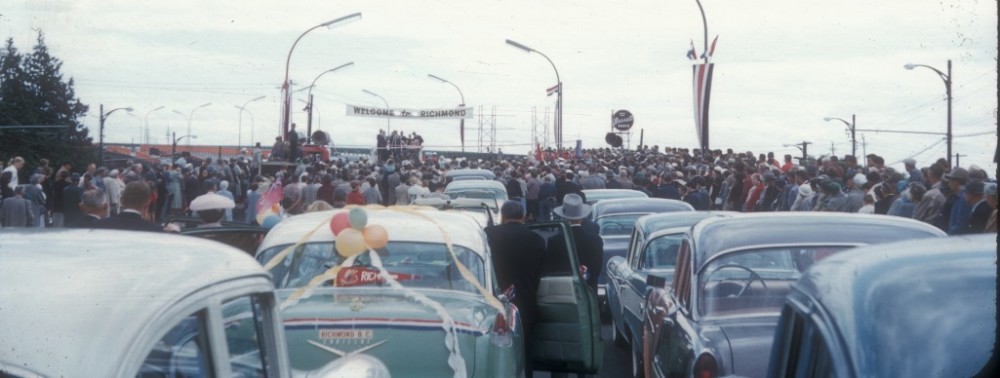
You must be logged in to post a comment.